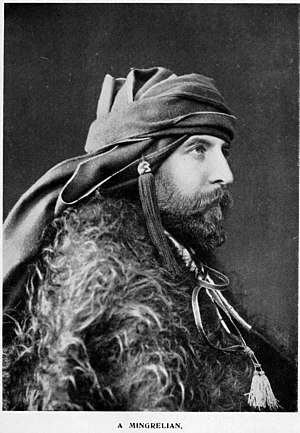Mingrelians
The Mingrelians[upper-alpha 1] (Megrelian: მარგალი, margali; Georgian: მეგრელები: megrelebi) are an indigenous Kartvelian-speaking ethnic subgroup of Georgians[3][4][5][6][7][8] that mostly live in the Samegrelo region of Georgia. They also live in considerable numbers in Abkhazia and Tbilisi. In the pre-1930 Soviet census, the Megrelians were afforded their own ethnic group category.[9][10]
 Distribution of Megrelian in relation to the other Kartvelian languages | |
| Total population | |
|---|---|
| c. 400,000 | |
| Regions with significant populations | |
| Languages | |
| Mingrelian, Georgian | |
| Religion | |
| Predominantly † Eastern Orthodox Christianity (Georgian Orthodox Church) |

| Part of a series on |
| Georgians ქართველები |
|---|
| Nation |
| Georgia |
| Ancient Kartvelian people |
|
| Subgroups |
| Culture |
|
| Languages |
| Religion |
| Symbols |
|
| History of Georgia |
The Mingrelians speak the Mingrelian language, and are typically bilingual also in Georgian. Both these languages belong to the Kartvelian language family.[11][12][13]
History
In the 13th century BC, the Kingdom of Colchis was formed as a result of the increasing consolidation of the tribes inhabiting the region, which covered modern western Georgia. The endonym Margali (მარგალი) is presumably reflected in the Greek Manraloi (Μάνραλοι), recorded as a people of Colchis by Ptolemy in the 2nd century BC.
By the mid-3rd century, the Lazi tribe came to dominate most of Colchis, establishing the kingdom of Lazica (or Egrisi in Georgian sources. In the 5th century, the first Christian king Gubazes I of Lazica declared Christianity as a state religion of Lazica. Locals began to have closer contact with the Greeks and acquired various Hellenic cultural traits, including in some cases the language. From 542 to 562, Lazica was a scene of the protracted rivalry between the Eastern Roman and Sassanid empires, culminating in the Lazic War. Emperor Heraclius's offensive in 628 AD brought victory over the Persians and ensured Roman predominance in Lazica until the invasion and conquest of the Caucasus by the Arabs in the second half of the 7th century.
In the 7th century Lazica fell to the Muslim conquest, however in the 8th century combined Lazic and Abasgian forces successfully repelled the Arab occupation. In 780 Lazica was incorporated to Kingdom of Abkhazia as a result of dynastic succession, the latter led the unification of Georgian monarchy in the 11th century. The nobility and clergy of Lazica switched from the Hellenic ecclesiastic tradition to the Georgian, and Georgian became the language of culture and education. After the fragmentation of the Kingdom of Georgia in the 15th century, Mingrelia was an autonomous principality within the Kingdom of Imereti, until being annexed by the Russian Empire in the 19th century.

In several censuses under the Russian Empire and the early Soviet Union, Megrelians were considered a separate group, largely because at the time of the annexation Samegrelo was politically separate from eastern Georgia, the historical political and cultural centers of the Medieval Georgian Kingdoms. They were, reclassified under the broader category of Georgian in the 1930s. Currently, most Megrelians identify themselves as a subgroup of the Georgian nation and have preserved many characteristic cultural features - including the Megrelian language - that date back to the pre-Christian Colchian era.
Lavrentiy Beria, the Chief of Stalin's secret police, was a Mingrelian. (As is well-known, Stalin himself was a Georgian.)
The first President of an independent Georgia, Zviad Gamsakhurdia (1939–1993), was a Megrelian.[14] Therefore, after the violent coup d'état of December 21, 1991 - January 6, 1992, Samegrelo became the centre of a civil war, which ended with the defeat of Gamsakhurdia's supporters.
Approximately 180,000-200,000 people of Georgian and Megrelian provenance have been expelled from Abkhazia as a result of the Abkhaz–Georgian conflict in the early 1990s and the ensuing ethnic cleansing of Georgians in this separatist region.
Notable Megrelians
- Konstantine Gamsakhurdia (1893-1975), one of the most influential Georgian writers of the 20th century[15]
- Zviad Gamsakhurdia (1939-1993), the first President of Georgia[14] (in office: 1991-1992)
- Lavrentiy Beria (1899-1953), Soviet chief of secret police in the later Stalin era[14]
- Merab Kostava (1939-1989), National Hero of Georgia[16]
- Şevkefza Sultan (c. 1825-1889), Ottoman Valide Sultan in 1876
See also
Notes
- Alternately, Megrelians, Mingrels, or Megrels
References
- Including Abkhazia, where 46,000 Megrels and Georgians
- Russian census 2010
- Stuart J. Kaufman Modern Hatreds: The Symbolic Politics of Ethnic War, p 86: «Additionally, the Georgian category includes an array of politically important subgroups especially Mingrelians, Svans and Ajarians»
- Kevin Tuite The Meaning of Dæl. Symbolic and Spatial Associations of the South Caucasian Goddess of Game Animals. Université de Montréal.
- Tunç Aybak Politics of the Black Sea: Dynamics of Cooperation and Conflict, p 185: «...Georgians (Megrels)...»
- Andropov, New Challenge to the West, by Arnold Beichman, Mikhail S. Bernstam, p 116: «Georgia consists of three ethnics tribes: Imeretians, Kartvels, and Mingrelians .»
- Small Nations and Great Powers: A Study of Ethnopolitical Conflict, by Svante E. Cornell, p 142
- Political Construction Sites: Nation-building in Russia and the Post-Soviet World, by Pål Kolstø, p 8
- R. Wixman. The Peoples of the USSR: An Ethnographic Handbook (s.134)
- National population census ZSFSR 1926
- Sorosoro.org
- McCauley, Martin. Who's who in Russia since 1900. Psychology Press, 1997: pg. 1
- Rayfield, Donald. Stalin and His Hangmen: The Tyrant and Those Who Killed for Him. Random House Digital, Inc., 2005: pg. 354
- Hoiris,Ole. Yurukel, Sefa. Contrasts and solutions in the Caucasus. Aarhus Univ. Press, 1998: pg.187
Bibliography
- Stephen F. Jones. Mingrelians. World Culture Encyclopedia.
| Wikimedia Commons has media related to Mingrelians. |
